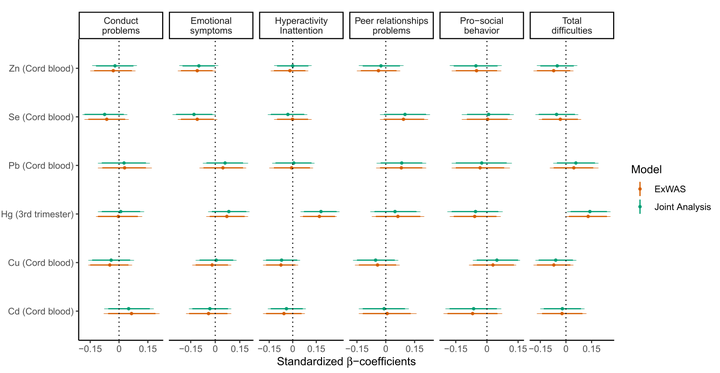Prenatal exposure to neurotoxic metals and micronutrients and neurodevelopmental outcomes in early school age children from Poland

Abstract
Exposure to environmental factors, such as neurotoxic metals and micronutrients, during critical periods of development can contribute to long-term consequences in offspring’s health, including neurodevelopmental outcomes. The aim of this study was to evaluate the association between simultaneous prenatal exposure to metals [lead (Pb), cadmium (Cd), mercury (Hg)] and micronutrients [selenium (Se), zinc (Zn), copper (Cu)] and neurodevelopmental outcomes in school-age children from the Polish Mother and Child Cohort (REPRO_PL).
Metals and micronutrients concentrations were measured in cord blood (Pb, Cd, Se, Zn, Cu) and in maternal hair (Hg) collected during the 3rd trimester of pregnancy. Behavioral and emotional problems, as well as children’s cognitive and psychomotor development, were assessed in 436 school-age children using the Strengths and Difficulties Questionnaire (SDQ, filled in by the mothers) and the Polish adaptation of the Intelligence and Development Scales (IDS, administered by trained psychologists). Multivariate regression models were applied after imputation of missing values, using two approaches: (i) a joint analysis taking into account all metals and micronutrients simultaneously, and (ii) an ExWAS study (single-exposure model).
In the SDQ, Hyperactivity/Inattention problems and Total difficulties were associated with higher Hg concentrations in maternal hair (0.18, 95% CI: 0.05; 0.3; and 0.14, 95% CI: 0.01; 0.3, respectively), whereas Emotional symptoms were inversely associated with Se and Zn levels in cord blood (−0.13, 95% CI: −0.3; 0.004; and −0.10, 95% CI: −0.2; 0.02, respectively). In the IDS, cord blood Pb levels were found to be negatively associated with Fluid and Crystallized IQ (−0.12, 95% CI: −0.3; 0.02; and −0.14, 95% CI: −0.3; 0.007, respectively) as well as Mathematical skills (−0.15, 95% CI: −0.3; 0.01).
The current research has been able to simultaneously assess the exposure to various interacting chemicals during the prenatal period. We demonstrate that prenatal co-exposures to Pb, Hg, Zn and Se have long-term influences on the neuropsychological outcome of school-age children.